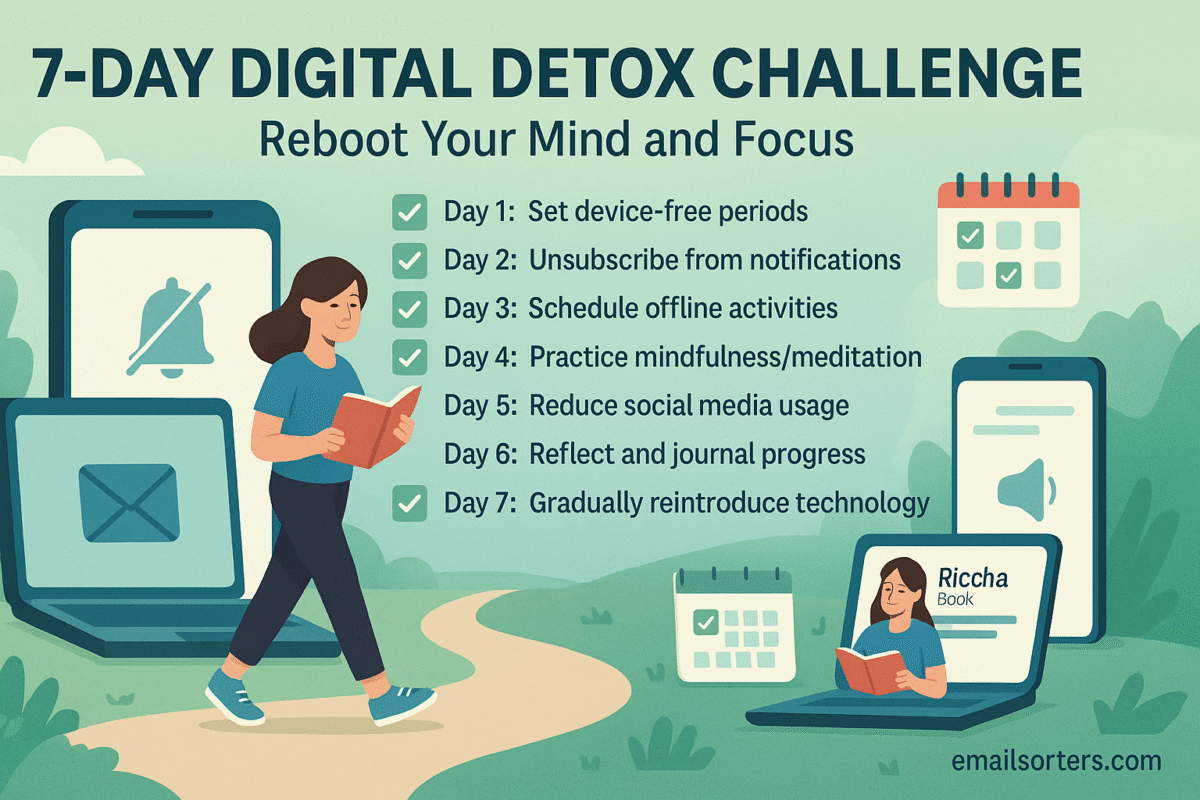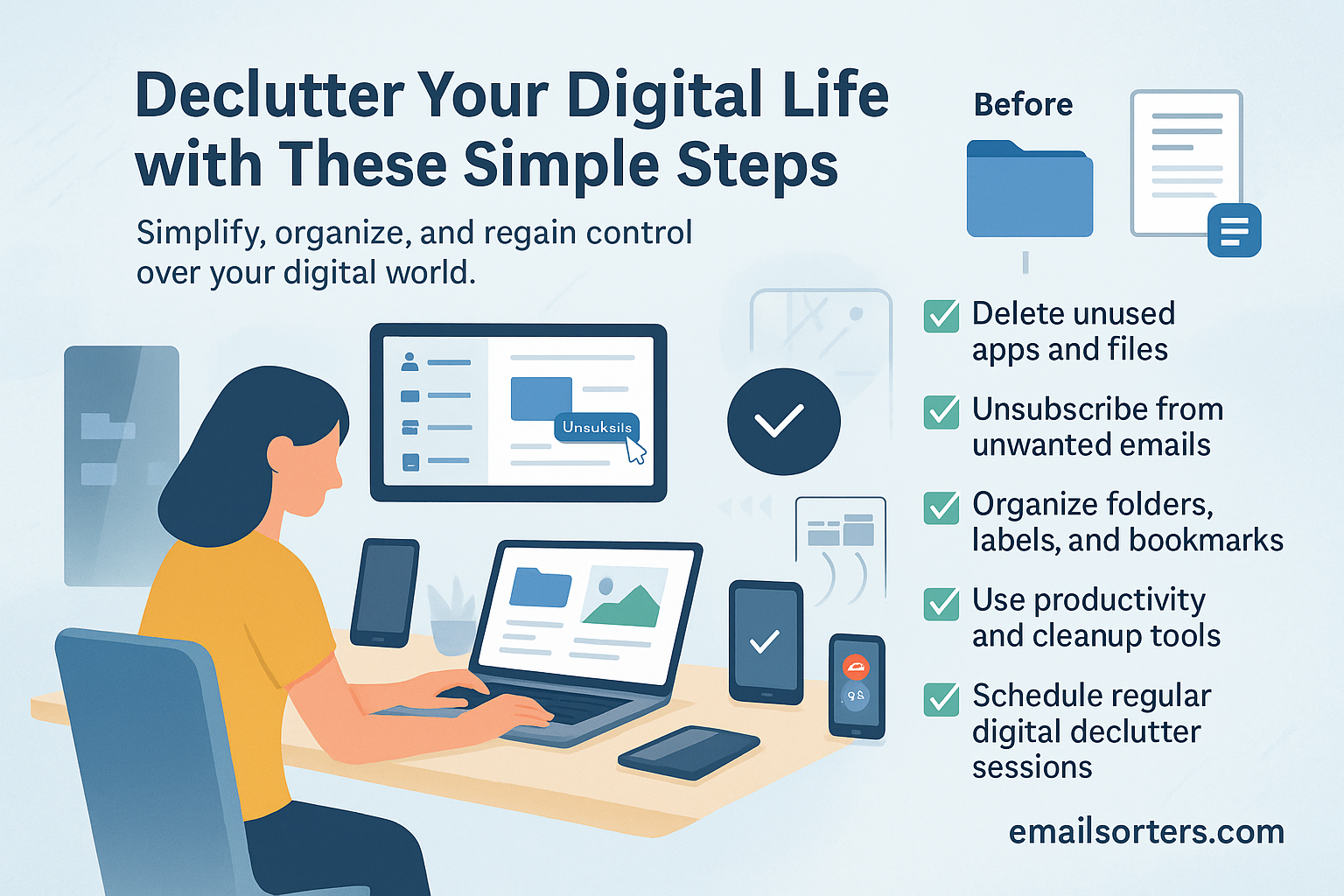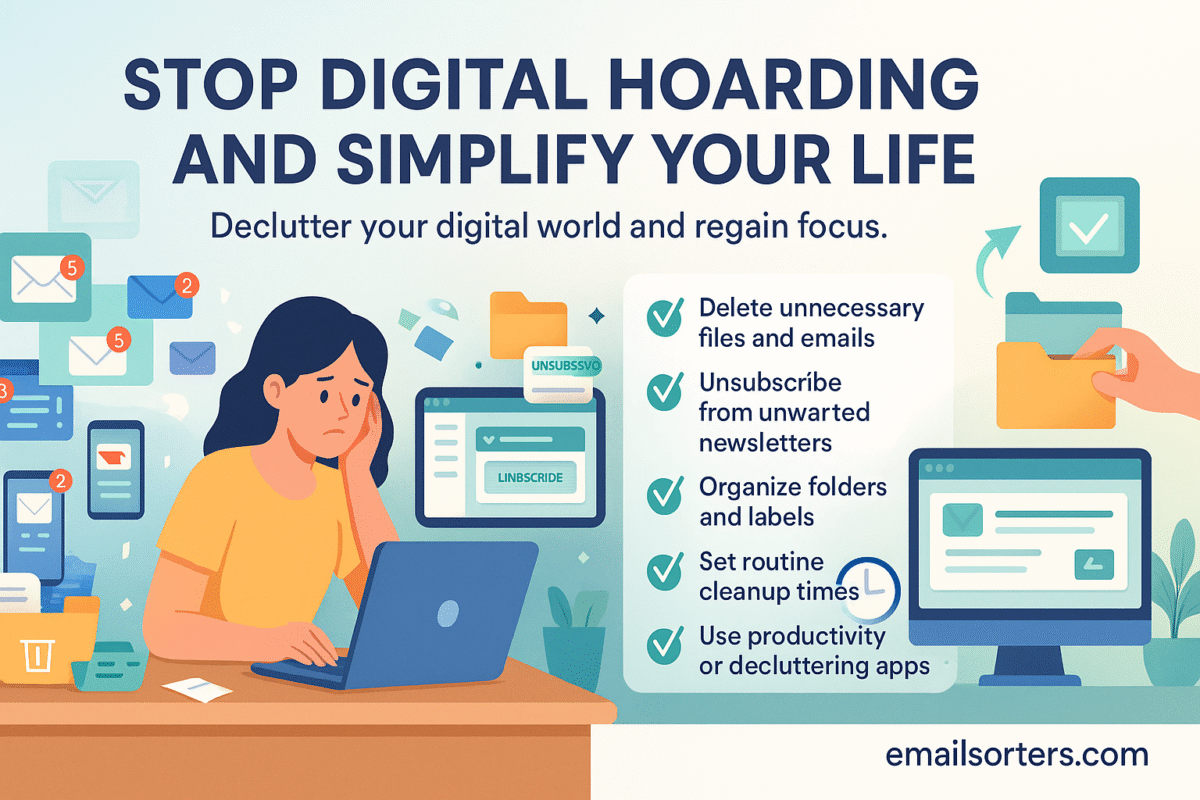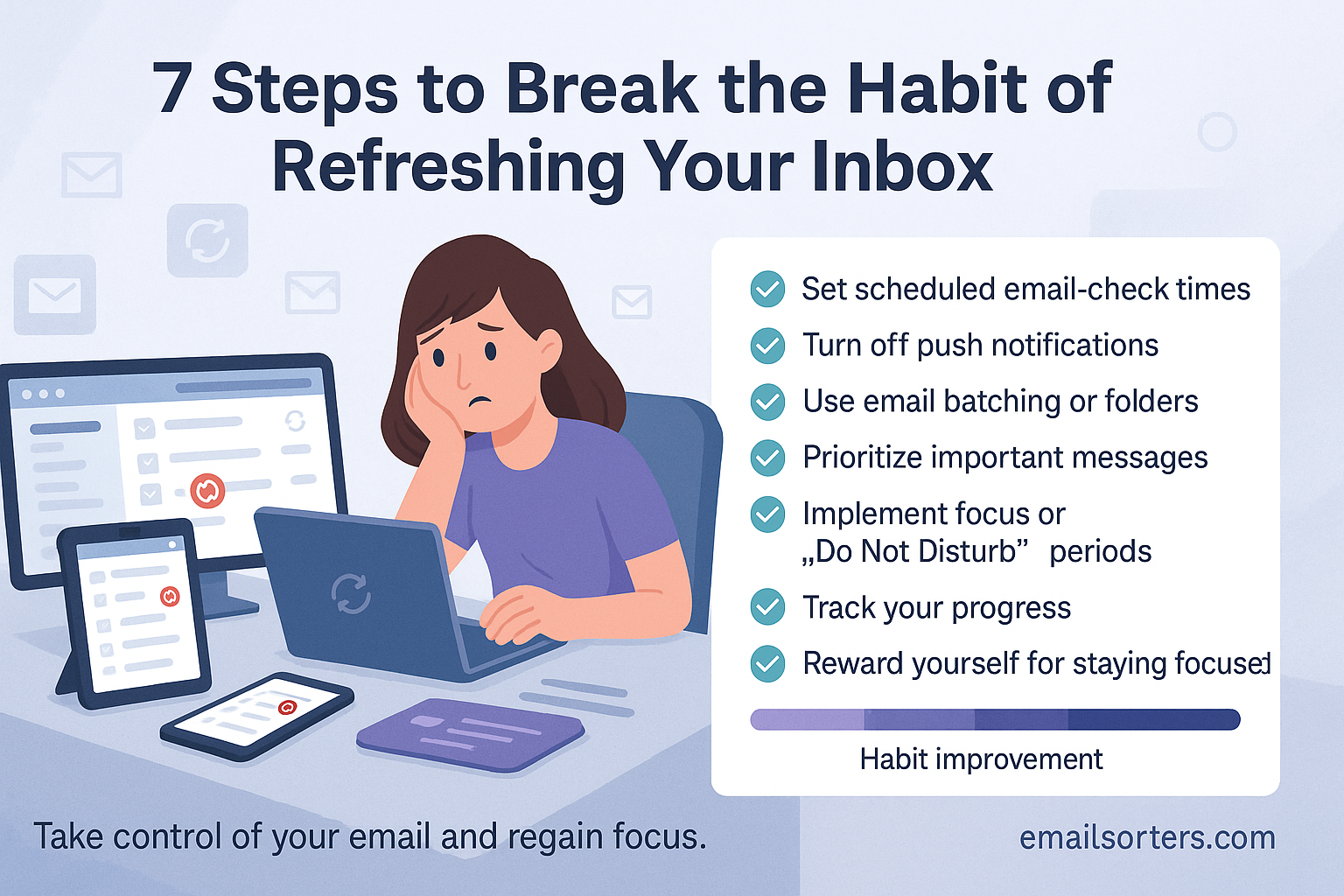Digital detox challenge sounds bold, maybe even a little scary. Could you really go a day (or more) without the endless scrolling, constant pings, and late-night screen time? Most of us know we’re too plugged in, but breaking away feels impossible.
That’s exactly why a detox challenge works. It gives you structure, a clear goal, and the push you need to reset your relationship with technology. Even small breaks can boost focus, improve sleep, and make you feel more present in real life.
We’re always connected, always scrolling, and always “on.” In this hyper-digital world, it’s easy to lose touch with real life; our time, our energy, even our sense of self. Notifications never stop. Social feeds are infinite. And somewhere between checking emails and binge-watching another episode, we start to feel foggy, unfocused, and downright exhausted.
That’s where the 7-Day Digital Detox Challenge comes in. This isn’t a tech purge or a dramatic digital disappearance; it’s a focused, intentional reset. Seven days to step back, regain clarity, and create a healthier relationship with your devices. Just one week to reduce screen time, improve your mental health, and rekindle joy in offline life.
Why seven days? Because it’s long enough to notice real change, but short enough to feel manageable. It gives your mind and body the chance to breathe while helping you break toxic habits and build better ones. Whether you’re feeling burnout, anxiety, distraction, or just the constant pull of your phone, this challenge is designed to help you reclaim your attention and reboot your life.
What You Can Expect from the Challenge
This isn’t about quitting technology cold turkey or isolating yourself in a cabin (unless you want to). It’s about taking small, purposeful steps each day to become more mindful of how you use your devices; and how they use you.
Each day of the challenge focuses on a different aspect of digital life. You’ll learn to audit your screen time, declutter your digital spaces, take a break from social media, reset your notifications, and create more space for real-world joy and connection. You’ll also be introduced to practical tools, techniques, and habits that make the detox stick; long after the week is over.
By the end of this challenge, you’ll feel lighter, more focused, and deeply refreshed. You’ll be back in the driver’s seat of your digital life. Ready? Let’s go.
Day 1 – Awareness and Audit
Tracking Your Screen Time Honestly
The first step in any detox is knowing where you stand. You can’t improve what you don’t measure. So today’s goal is simple: become aware of your current digital habits. That means tracking your screen time across all devices and apps; without judgment, just curiosity.
Start by enabling built-in tools on your devices:
- iPhone/iPad: Go to Settings > Screen Time
- Android: Use Digital Wellbeing under Settings
- Windows/macOS: Use apps like RescueTime or native screen time monitors
Look at how many hours you spend on each app. How often do you pick up your phone? What time of day do you spend the most online? Which apps are your biggest time sinks?
Write it all down. Create a simple log or use a journal. Capture not just the numbers, but how you feel when you’re using each platform. Do you feel relaxed? Productive? Anxious? Drained?
This isn’t about feeling guilty. It’s about shining a light on your behavior so you can take control. You may be shocked to find you’ve been spending 4–6 hours a day on your phone; or that your social media use is double what you thought. That’s okay. Today, you’re simply observing.
Identifying Digital Habits and Triggers
Now that you’ve seen the data, let’s dig deeper. What are the emotional and situational triggers behind your screen time? Ask yourself:
- Do I check my phone when I’m bored, anxious, or lonely?
- Am I using screens as a reward; or an escape?
- Which apps do I open mindlessly?
- Do certain people, places, or emotions cause me to reach for my phone?
Write these insights down. Noticing your digital patterns is the foundation for lasting change. Tomorrow, you’ll begin taking action to simplify and reset.
Day 2 – Declutter Your Digital Space
Cleaning Your Phone and Desktop
Digital clutter is like digital noise. You may not see it all the time, but it takes up mental space and slows you down. Today’s mission is to clean up the visual and digital chaos; starting with your phone and computer.
Begin with your smartphone:
- Delete apps you haven’t used in the last 30 days
- Remove duplicate or blurry photos
- Clear your downloads and junk files
- Organize apps into folders for clarity
- Change your wallpaper to something calm or inspiring
Now tackle your computer:
- Clean your desktop; no files, no clutter
- Organize documents into labeled folders
- Trash any unnecessary downloads or temporary files
- Clear your browser tabs and cache
Think of it like cleaning out your digital closet. You’re not just making space on your device; you’re making space in your mind. And when your digital world is clean, it becomes easier to focus, create, and breathe.
Unsubscribing and Uninstalling
Next, go on an unsubscribe spree. Open your email inbox and search “unsubscribe.” Start clearing out the newsletters, promos, and updates that clutter your attention. Tools like Unroll.Me or Clean Email can help speed things up.
Then uninstall unnecessary software and browser extensions. Each one may seem small, but together, they slow you down and distract you. The fewer digital tools you have, the more you value the ones you keep.
Finally, take a moment to step back and admire your work. Your digital space is already feeling calmer. You’re creating room for what really matters. And you’re just getting started.
Day 3 – Social Media Fast
Logging Out to Regain Mental Space
Today, we take a bold step: a 24-hour social media fast. That means no Instagram, Facebook, Twitter/X, TikTok, LinkedIn, or any other platform you use regularly. Yes, it might feel strange at first; but that’s kind of the point.
Social media is designed to keep you hooked. Every scroll, like, and swipe releases dopamine. It’s fun in the moment; but exhausting over time. Taking a break allows your brain to reset and lets you see how much energy you’ve been pouring into digital interactions.
Start by logging out of all your accounts. Delete the apps if needed (you can always reinstall later). Tell your followers you’re taking a short break if you feel the need.
Now pay attention. How often do you reach for your phone without thinking? How do you feel when you resist? Noticing these cravings is powerful; it gives you back control.
Replacing the Habit with Real Engagement
Social media often fills a void; boredom, loneliness, anxiety. Today, choose healthier ways to fill that space. Call a friend. Take a walk. Read a book. Journal your thoughts. Cook a meal. Visit a local park or coffee shop. Do something that connects you with the real world.
You might be surprised by how much more present you feel. By the end of the day, you’ll likely feel clearer, lighter, and less emotionally reactive. That’s what happens when you stop letting algorithms dictate your attention.
Tomorrow, we’ll focus on the notifications that constantly pull you away from what matters.
Day 4 – Email and Notifications Reset
Inbox Cleanup and Filter Setup
Let’s face it; email can feel like a second job. If your inbox is overflowing, your brain is constantly scanning for danger, deadlines, and demands. Today’s challenge is to reduce that pressure by cleaning your inbox and creating a more manageable system.
Start by deleting or archiving old messages. If it’s more than 30 days old and not mission-critical, it can go. Next, create folders for categories like “Bills,” “Receipts,” “Work,” and “Family.” Move emails accordingly.
Set up filters to automatically sort incoming messages. In Gmail, use “Filters and Blocked Addresses” under Settings. For example, filter all emails from Amazon into a “Shopping” folder or auto-archive newsletters you rarely read.
Finally, unsubscribe from anything that doesn’t serve you. Use today to streamline your email so it serves you; not the other way around.
Disabling Distractions to Regain Focus
Now tackle your notifications. These little pings might seem harmless, but they destroy your focus and feed your compulsive checking habit.
Here’s what to do:
- Disable non-essential app notifications
- Use “Do Not Disturb” during work or rest hours
- Turn off badge icons that pressure you to respond
- Mute group chats temporarily if they’re noisy
These small tweaks create massive improvements in focus and calm. Your attention is your most valuable resource; stop giving it away for free.
Day 5 – Create Screen-Free Zones and Hours
Redesigning Your Environment for Balance
By Day 5, you’re likely starting to feel the shift. You’re more aware of your habits, you’ve taken meaningful steps to declutter, and your screen time is probably decreasing. Now it’s time to protect your progress by designing your environment for digital balance.
Today’s challenge is about creating screen-free zones; physical spaces in your home or office where technology is off-limits. These might include:
- Your bedroom, to improve sleep and reduce late-night scrolling.
- The dining table, to foster better conversations and mindful eating.
- Your bathroom (yes, really), to keep hygiene and attention in check.
- A reading nook or quiet corner for unplugged time with books or meditation.
Physically removing devices from these areas (or putting them out of sight) makes it easier to maintain the boundary. Use baskets or designated charging stations to keep your phone away when you’re in those zones.
Then, create screen-free hours. These might be the first hour after waking and the last hour before bed; prime time for mindfulness, reflection, and rest. During these windows, avoid all screens, including phones, computers, and TVs.
By setting these boundaries, you’re telling your mind and body: this is time for rest, focus, and connection. And the benefits will speak for themselves; deeper sleep, less stress, more presence.
Implementing Morning and Evening Routines
Use this day to establish new routines that nourish your mind and body without screens. A tech-free morning could include journaling, stretching, drinking water, or simply sitting in silence. Resist the urge to check your phone first thing; it can wait.
An evening routine might involve reading, dimming the lights, using essential oils, or practicing gratitude. Keep a physical book or notebook by your bed instead of your phone.
These analog rituals calm your nervous system and reduce the mental clutter caused by late-night digital stimulation. Over time, they’ll become your go-to reset buttons, helping you wind down and wake up with intention.
Day 6 – Digital-Free Activities and Real Connections
Offline Hobbies to Reconnect with Joy
You’ve spent nearly a week cutting out digital distractions. Today, it’s time to fill that reclaimed space with things that bring you joy, presence, and creativity; offline hobbies and analog pleasures.
What did you used to love doing before your phone became your go-to entertainment? What sparks joy, curiosity, or peace?
Try one or more of the following:
- Drawing, painting, or journaling
- Reading a novel or magazine
- Cooking a new recipe from a physical cookbook
- Gardening or going for a nature walk
- Playing an instrument or singing
- Doing puzzles or playing a board game
These simple pleasures ground you in the present and engage your senses in ways screens can’t. The goal is not productivity; it’s play, flow, and fulfillment.
Spending Intentional Time with Others
Digital detoxing also reveals just how much we substitute virtual connection for real-world intimacy. Use today to deepen relationships offline.
Make plans with a friend, have a phone-free coffee date, eat dinner with family without screens, or write a letter to someone you care about. Even a shared walk or tech-free conversation with a roommate can be powerful.
Connection is the antidote to digital overload. And when you’re fully present, your relationships become richer, deeper, and more meaningful.
Day 7 – Reflection and Rebuilding
What You Learned from Detoxing
Congratulations; you’ve made it to Day 7! This is your time to reflect on the journey, notice the changes, and begin building your new digital life with intention.
Take 10–15 minutes to answer these questions in a journal:
- What surprised you most during this challenge?
- What digital habits did you break; or begin?
- When did you feel the most clear, calm, or focused?
- Which apps or platforms do you no longer miss?
- What were the hardest parts of detoxing?
Write freely. Your insights are powerful. They reveal not just your screen habits, but what truly matters to you.
Crafting Your Long-Term Digital Plan
Now, take what you’ve learned and turn it into a sustainable plan. Ask yourself:
- Which habits do I want to continue?
- Which apps or platforms should I limit; or remove permanently?
- What will my screen-free hours be each day?
- When will I schedule regular digital detoxes?
You don’t need a rigid plan. Just a few solid boundaries and routines that support your values, goals, and well-being.
Commit to a weekly mini-detox (like a screen-free Sunday) or a monthly reset weekend. These small check-ins help maintain balance and prevent relapse.
Tools and Resources to Support Your Journey
Recommended Apps and Practices
Ironically, a few good digital tools can help you maintain better digital habits. Try:
- Forest (Stay focused by growing virtual trees during screen-free time)
- Freedom (Blocks distracting apps and websites)
- Moment or Digital Wellbeing (Tracks and limits screen time)
- Notion or Evernote (Organizes offline goals, journaling, and reflections)
Also, consider printing out this challenge and repeating it once a quarter; or sharing it with a friend.
Digital Wellness Books and Podcasts
Want to go deeper? Check out:
- Digital Minimalism by Cal Newport
- How to Break Up with Your Phone by Catherine Price
- The Power of Unplugging by Tanya Goodin
Podcasts like The Digital Mindfulness Podcast or The Minimalists offer practical advice and inspiration to keep you on track.
Overcoming Common Detox Challenges
Dealing with Withdrawal and FOMO
The first few days of detoxing can be tough. You might feel restless, anxious, or even a little lost. That’s normal. Your brain is adjusting to a new rhythm; one without constant stimulation.
When withdrawal hits:
- Get up and move
- Breathe deeply or meditate
- Call a friend or write in your journal
- Remind yourself why you started
FOMO is real too, but it fades. Most things online can wait. And when you’re grounded in real life, the fear of missing out turns into the joy of missing out; JOMO.
Staying Committed Through Discomfort
Digital detoxing is like training a muscle. The first few reps are the hardest. But if you push through the discomfort, your attention span strengthens, your mind clears, and your craving for screens diminishes.
When you’re tempted to give up, revisit your Day 1 audit. See how far you’ve come. Remember how it felt to truly rest, focus, or connect. That’s your why.
You’ve done the hard part. Now make it stick.
Conclusion
A 7-day digital detox isn’t just about breaking habits; it’s about creating space. Space to breathe, think, feel, and live more fully. In just one week, you’ve decluttered your mind, regained your time, and proven to yourself that you can thrive without constant connectivity.
But don’t stop here.
Make digital detoxing a regular part of your life. Use this challenge as a reset whenever you feel overwhelmed. And share it with others; because the more people reclaim their time and attention, the better our world becomes.
You’ve just taken a powerful step toward a healthier, more intentional digital life.
FAQs
Can I use my phone at all during the challenge?
Yes, but with intention. This challenge encourages reduced, mindful use; not complete abstinence. Use your phone for essential tasks, not mindless scrolling.
What if I need tech for work or emergencies?
That’s totally fine. Customize the challenge to fit your life. Focus on limiting non-essential digital use outside of work hours.
Is one week enough to make a difference?
Absolutely. Seven days is long enough to notice clearer focus, better sleep, less stress, and more presence. Many people experience life-changing results in that short time.
How can I detox without missing important updates?
Set clear expectations. Tell friends, coworkers, or clients that you’re detoxing and provide alternate contact methods if necessary. Use auto-responders if needed.
Should I repeat the challenge regularly?
Yes! Many people repeat the detox monthly or quarterly. The more consistently you reset, the easier it becomes to maintain digital balance.




